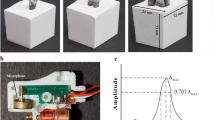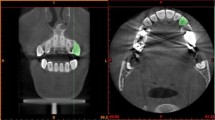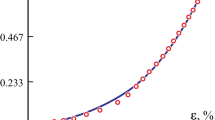Abstract
The vibration characteristics of a maxillary central incisor were investigated by using the finite element method (FEM) according to nonlinear behavior of the human periodontal ligament (PDL). The effect of alveolar bone loss was also studied to obtain the relationship between the vibration property of the tooth in the periodontal system and the level of periodontal attachment for assessing the condition of periodontium. Three-dimensional (3D) finite element model of the tooth was constructed using CT image-reconstruction, and the elastic face foundation constraint was applied to the surface of the tooth root where the PDL was attached to. Modal analysis was performed by using FEM. The nonlinear behavior of the PDL was assigned and approached by the piecewise linearized method. The results indicated that the vibration of the maxillary central incisor in the periodontal system could be described by several modal frequencies and modes. The first four modes were dominant, which varied with the deformation of the PDL or the force applied on the tooth. The vibration frequency of the maxillary central incisor decreased with the losing of the alveolar bone, but the ratio of decrease had no significant correlation with the nonlinear behavior of the human PDL. The vibration frequency of the maxillary central incisor can be used to describe the loss of the alveolar bone and the level of periodontal attachment, under physiological short-term loading.








Similar content being viewed by others
References
Nishimura M, Chiba M, Ohashi T et al (2008) Periodontal tissue activation by vibration: intermittent stimulation by resonance vibration accelerates experimental tooth movement in rats. Am J Orthod Dentofacial Orthop 133(4):572–583
Lee SY, Huang HM, Lin CY et al (2000) In vivo and in vitro natural frequency analysis of periodontal conditions: an innovative method. J Periodontol 71(4):632–640
Huang H-M, Tsai C-Y, Lee H-F et al (2005) Damping effects on the response of maxillary incisor subjected to a traumatic impact force: a nonlinear finite element analysis. J Dent 27(6):1–8
Huang HM, Lee SY, Yeh CY et al (2001) Natural frequence analysis of periodontal conditions in human anterior teeth. Ann Biomed Eng 29(10):915–920
Kojima Y, Fukui H (2007) Calculation of natural frequencies of teeth supported with the periodontal ligament. Dent Mater J 26(2):254–259
Yamane M, Yamaoka M, Hayashi M et al (2008) Measuring tooth mobility with a no-contact vibration device. J Periodont Res 43(1):84–89
Toms SR, Lemons JE, Bartolucci AA et al (2002) Nonlinear stress–strain behavior of periodontal ligament under orthodontic loading. Am J Orthod Dentofacial Orthop 122(2):174–179
Cronau M, Ihlow D, Kubein-Meesenburg D et al (2006) Biomechanical features of the periodontium: an experimental pilot study in vivo. Am J Orthod Dentofacial Orthop 129(5):13–21
Clement R, Schneider J, Brambs H-J et al (2004) Quasi-automatic 3D finite element model generation for individual single-rooted teeth and periodontal ligament. Comput Meth Programs Biomed 73(2):135–144
Boccaccio A, Prendergast PJ, Pappalettere C et al (2008) Tissue differentiation and bone regeneration in an osteotomized mandible: a computational analysis of the latency period. Med Biol Eng Comput 46(3):283–298
Pi Xin (2007) Dental anatomy physiology. People’s Medical Publishing House, Beijing
Toms SR, Eberhardt AW (2003) A nonlinear finite element analysis of the periodontal ligament under orthodontic tooth loading. Am J Orthod Dentofacial Orthop 123(6):657–665
Ziegler A, Keilig L, Kawarizadeh A et al (2005) Numerical simulation of the biomechanical behaviour of multi-rooted teeth. Eur J Orthodont 27(5):333–339
Kawarizadeh A, Bourauel C, Jäger A (2003) Experimental and numerical determination of initial tooth mobility and material properties of the periodontal ligament in rat molar specimens. Eur J Orthodont 25(6):569–578
Provatidis CG (2000) A comparative FEM-study of tooth mobility using isotropic and anisotropic models of the periodontal ligament. Med Eng Phys 22(5):359–370
Uddanwadiker RV, Padole PM, Arya H (2007) Effect of variation of root post in different layers of tooth: linear vs nonlinear finite element stress analysis. J Biosci Bioeng 104(5): 363–370
Chang YH, Lin WH, Kuo WC et al (2009) Mechanical interactions of cuspal-coverage designs and cement thickness in a cusp-replacing ceramic premolar restoration: a finite element study. Med Biol Eng Comput 47(4):367–374
Slomka N, Vardimon AD, Gefen A et al (2008) Time-related PDL: viscoelastic response during initial orthodontic tooth movement of a tooth with functioning interproximal contact—a mathematical model. J Biomech 41(9):1871–1877
Parfitt GJ (1960) Measurement of the physiological mobility of individual teeth in an axial direction. J Dent Res 39(3):608–615
Natali AN, Pavan PG, Scarpa C (2004) Numerical analysis of tooth mobility: formulation of a non-linear constitutive law for the periodontal ligament. Dent Mater 20(7):623–629
Lin S-L, Lee S-Y, Lee LY et al (2006) Vibration analysis of mandible trauma: experimental and numerical approaches. Med Biol Eng Comput 44(9):785–792
Huang H-M, Yeh C-Y, Lee S-Y et al (2001) Factors influencing the dynamic behaviour of human teeth. Med Biol Eng Comput 39(4):176–181
Zhurov AI, Limbert G, Holt C (2006) A non-linear anisotropic constitutive model for the periodontal ligament. J Biomech 39(Suppl 1):S202
Melsen B, Cattaneo PM, Dalstra M et al (2007) The importance of force levels in relation to tooth movement. Semin Orthod 13(4):220–233
Tanaka E, Inubushi T, Takahashi K et al (2007) Dynamic shear properties of the porcine molar periodontal ligament. J Biomech 40(7):1477–1483
Wakabayashi N, Ona M, Suzuki T et al (2008) Nonlinear finite element analyses: advances and challenges in dental applications. J Dent 36(7):463–471
Pini M, Zysset Ph, Botsis J et al (2004) Tensile and compressive behaviour of the bovine periodontal ligament. J Biomech 37(1):111–119
Shao F, Xu W, Crocombe A (2007) Natural frequency analysis of osseointegration for trans-femoral implant. Ann Biomed Eng 35(5):817–824
Author information
Authors and Affiliations
Corresponding author
Rights and permissions
About this article
Cite this article
Xin, H., Li, Y., Zhao, L. et al. Nonlinear finite element analysis of the vibration characteristics of the maxillary central incisor related to periodontal attachment. Med Biol Eng Comput 47, 1189–1195 (2009). https://doi.org/10.1007/s11517-009-0542-0
Received:
Accepted:
Published:
Issue Date:
DOI: https://doi.org/10.1007/s11517-009-0542-0




